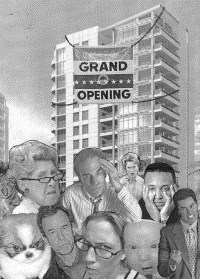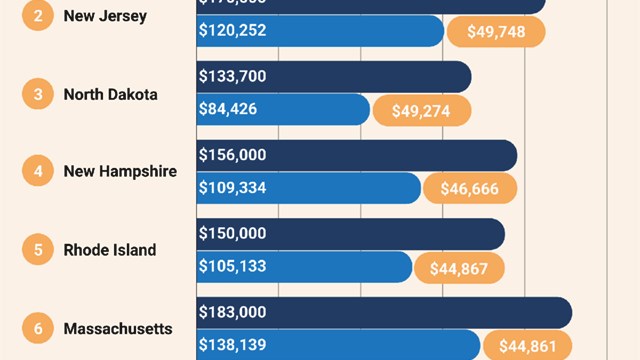
Everyone's heard the old saying about how "They don't make 'em like they used to" applied to everything from cars to appliances. But does the same hold true for residential buildings? A spirited debate surrounds the issue of whether today's glass-and-steel (or zinc, or titanium) condo towers are less well made than the stone-and-mortar edifices raised at the turn of the last century.
A spate of recent news items in a number of publications has raised red flags about the potential risks and hassles of buying brand-new apartments—but is the alarm justified? What should a homebuyer know—or know to look out for—when buying into a newly constructed building?
The Airing of Grievances
Problems in new construction range from builders swapping promised luxury finishes for cheaper substitutes to leaving wiring dangerously exposed.
"Sloppy workmanship creates huge issues," says C. Jaye Berger of the Law Offices of C. Jaye Berger, a Manhattan attorney specializing in construction-related issues. "There are things that violate codes—like vents being put in at the ground level instead of the roof—and there are also a lot of problems with leakage. Some developers are on top of it, and build precautions into the developments like pumps and waterproofing, but others don't."
Other complaints arise out of poor planning and execution, continues Berger. "In one case, my client bought an apartment where all the cables for the entire building were in my client's unit. That means any time anyone in the building needs the cable guy to come in, they have to get access to my client's apartment. That's just stupid. It's bad construction," she says.
Efforts to save time and money backfire in many cases, says Wayne Bellet of Manhattan-based Bellet Construction. "Things being omitted are as simple as a small tube, which costs pennies, that goes in above the window frame and allows water to come out from behind the brick to the front of the façade. That is really petty, to not install something as inexpensive and necessary as that."
Haste Makes Waste
Among the professionals interviewed for this article, one remark was heard over and over again: whenever there's a building boom in the city, reports of dissatisfaction and defects in new construction spike. This may be due in part because more people are buying units, but also because when demand increases at a breakneck pace, developers and builders may be more tempted to take shortcuts in order to keep up.
"We've been in business long enough that we see this in every construction boom cycle," says Howard Zimmerman of Howard L. Zimmerman Architects PC in Manhattan. "We're in a boom now, and there's a limited workforce of experienced labor that can building quality housing. The bigger the boom, the more buildings are built, and the farther out in the labor pool they have to go to get people to build."
The issue also comes back to the ever-ticking clock. "While the bank fees [and] the bridge loans are accruing, the sponsors have to open these model apartments," says Bellet. "They will snap the whip at the trades to get these spaces finished, so that they can be pre-sold before the building is even open. If these spaces are done in a hurry, you can imagine how the rest are done."
So who's at fault when a drainage tube isn't installed, or an apartment turns out to be full of leaks? According to Bellet, it's difficult—and somewhat unfair - to pin responsibility on one person or group. "The truth is, it's pervasive. The banks want their money faster, so they're walking through, passing things without looking; the contractors are not doing quality work; the project managers and general contractors want it on the market fast, so they're looking the other way. Everyone is at fault, no one more than another."
According to Berger, inexperience in the development game overall is often a factor when a new building has problems. "With the kind of thing that I'm seeing, you often don't know who the developer is," says Berger. "Many times, they're not experienced as developers, and there may a lot of shoddy workmanship and cutting corners if the sponsor is also the contractor."
The Self-Certification Issue
"In order for people to move into a building, they need a Certificate of Occupancy," says Edward Braverman, an attorney with Manhattan-based law firm Braverman & Associates. "But before the city will issue the certificate, they demand a lot of paperwork from builders verifying that the new building is code compliant and adheres to certain standards. "In order to get the temporary certificate, the city has a multitude of issues that must be addressed, many of them by self-certification."
"Self-certification" refers to the practice of allowing the architect or engineer on a development project to essentially give their word that the construction is up to code and free of defects.
"It's not like there's a 'Bureau of Construction and Co-op Review,'" says Berger. "There is no such thing. The Department of Buildings (DOB) is looking at certain things, but there is an awful lot of self-certification work being done, and the DOB does not come and look. That's part of the problem. The work that we are complaining about is not reviewed by the city, it's self certified."
According to Berger, "A lot of people don't think [self-certification] is a great idea, because you don't really have the city's stamp of approval—you have an architect who has been deputized. If you have a sponsor who is trying to cut corners, he may tell the architect not to come by so often to look at the work; we'll take care of it. You don't know what is going on in that relationship."
Braverman believes there is a conflict of interest that makes self-certification a major problem. "I have felt for a long time, and have written to [Buildings Commissioner] Patricia Lancaster, that I believe that self-certification is one of the basic problems that is going on in New York City today," he says. "I think that architects and engineers have too much at stake personally to be permitted to sign off on these buildings. We have a case now where six floors of a self-certified building have a wall that is not fireproof, which is against code."
DOB spokesperson Carly Sullivan feels that self-certification isn't necessarily a recipe for problems. "Over the past year and a half, the Buildings Department has expanded its Zoning Review Pilot Program to the Bronx, Staten Island, Brooklyn and Queens. Under the program, plan examiners review all professionally certified new building and alteration Type 1 applications for commonly abused zoning regulations. With the new Special Enforcement Plan announced in July by Mayor [Michael R.] Bloomberg, this program will be expanded to Manhattan and become permanent."
"The new Special Enforcement Plan is designed to crack down on repeat offenders and will also increase inspections of professionally certified jobs," Sullivan continues. "In addition to these proactive enforcement initiatives, legislation passed recently at the state level authorizes the DOB to prevent those who have falsely filed from obtaining permits. This legislation, along with our new special enforcement plan, is a big step toward cracking down on abuses of professional certification."
Signs of Trouble
For the average new apartment buyer with a budget and a move-in deadline, whether their building was city-certified or self-certified may be a moot point. So what should a person look for if they're about to buy a unit in a spanking-new building? According to Bellet, some signs of sub-par construction are obvious, and if the unit is complete, a buyer can check for them.
"Let the dishwasher run, check the heat, put the air conditioner on, flush the toilets, anything that you can do to challenge it. Don't just be grateful that you can afford it. Lawsuits to correct these issues will prove very expensive."
Kate Lindquist, press secretary for the DOB, adds that some immediate tip-offs of shoddy construction are: "Water stains… buckled or warped floors… sloppy attention to cosmetics that could indicate an overall lack of professionalism on the part of the developer and the individuals hired to do the work."
Unfortunately, there is a limit to what a buyer with an untrained eye can suss out for themselves, says Berger. "There's only so much that a lay person will be able to notice. There are code violations, the boiler isn't hooked up right, there's a dent in the boiler where there shouldn't be, there are combustible materials in the boiler room…" those things, you won't see until they manifest as big problems later on.
That's why buyers should have the help of an objective professional. "You cannot buy a place like this without having it inspected," says Berger. "So much work has been done, and someone should come in to make sure all the pieces fit together. You need a good expert, someone to tell you everything that needs attention. I usually try to use an engineer to inspect. There are companies that provide expert witnesses. [They] will put the developer on notice if there are problems."
Once the Contract's Signed
But what if you're a proud new apartment owner who's only now realized that the appliances built into your place are leaking all over the floor, which was supposed to be hardwood but turned out to be veneers, or that the walls have all the soundproofing of a tin can?
At that point, says Berger, "They should go to a lawyer. When you deal with problems of this magnitude, the dollars that are involved are at such a level that once you pay a million dollars for an apartment, you can't afford to be fixing construction. Get appropriate legal counsel, someone who really understands this stuff," she advises.
There are three ways in which problems like this can be resolved, says Braverman. "One, you can try to get the developer to come back and fulfill his obligations. Two, the attorney general can sue the developer under the Martin Act if the construction doesn't comport with the plan, and can possibly prevent the developer from future New York construction and development. Three, there's a lawsuit - which is expensive and time consuming, and really only a last resort."
So…New, or Not-So-New?
With the problems that can crop up in post-boom buildings, might a buyer be smarter to look at apartments in older, more established buildings?
Braverman for one, says yes. "I tell them, why don't you buy from a building that has been around for about 5 years or so. You can see any construction problems in the minutes of the board meetings and the annual financial statements," he says. "I don't want to paint every developer with the same brush, but many of the [newer properties] do not get finished on time, and they're often disappointing in the finishes. Buy one that has been around and had its kinks worked out. Advance purchases, where you pay before the unit is finished are really problematic. New York has been such a hot housing market that developers have been able to bully people into buying without looking, without inspecting and without adequate time to review their contract."
Bellet agrees, to a point. "I have a bias because my father and grandfather built the buildings of the recently past eras," he says. "I can tell you that older, prewar construction is better construction, but as much as I endorse those older buildings…those buildings have older parts, and crazy-quilt repair work. They may put in a new patch, but one at a time. Replacing the boiler is followed by necessary pipe replacement. We fix things when they're broken. That gives everything in these older buildings a different rate of aging."
In the final analysis, says Berger, "You have to have a good team put together. There are lots of sponsors who will step up to the plate to fix issues, but there are lots who don't. The latter doesn't help anybody; it doesn't help the sponsor's reputation, and it doesn't help the brokers. The best thing they can do is to fix the issues that arise."
Denton Tarver is a freelance writer, teacher, and professional gardener living in New York City.






Comments
Leave a Comment